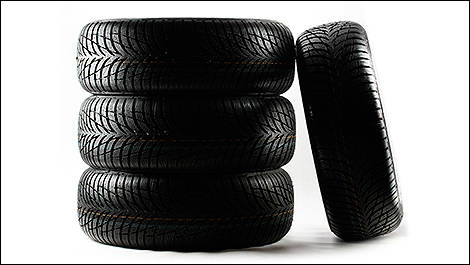As the fantastic spring season approaches, consumers (and I) begin dreaming about removing the dastardly, yet ultra-important, winter tires and ugly rims from our cars and exchanging them for our gorgeous alloy wheels.
Depending on the province you call home, winter tires are actually a legal requirement so the choice is not yours when it comes to making a concession on tires. I’m talking about all-season tires.
Here’s a fun fact: Only in North America do we have an “All-Season” designation for tires. As per its definition, the A/S tire is a compromise and the trick is to manage the compromise. It would seem as though the rest of the world is not interested in compromises.
For some reason, we North Americans decided that we were willing to sacrifice performance and a certain degree of safety in order to save a few bucks. Given the sheer size of our combined Canada-US market, tire manufacturers have been more than happy to oblige.
Yes, tire manufacturers are trying hard to make a single tire perform well in all instances, road conditions and temperatures. Now this is quite a challenge and the big tire makers are getting closer and closer to creating and designing the perfect (albeit compromised) all-season tire.
Brands such as Continental, Bridgestone and, most recently, Michelin have come supremely close to offering a tire capable of tackling the vast majority of driving conditions we face 90% of the time. On top of that, the crew at Michelin managed to throw in the mix some “high-performance” capabilities. Take a look at my review of the new Michelin Pilot Sport A/S 3.
What’s their secret? It is what was once largely reserved for winter tires, and it is called silica. Silica, the oldest worst-kept secret in the tire business is a key ingredient. Its main ability is to offer plenty of grip in wet and cold conditions. The proportion and mix of the ingredients is the real secret. Silica helps with stability, the principal aspect and characteristic of a good tire.
So, silica, once more or less reserved for winter tires, is working its way into all types of tires including low-rolling resistance as it helps to combat tire deformation under load. This is the principal cause for rolling resistance which increases fuel consumption.
What can we take away from this? Other than good all-season tires such as the Pilot Sport A/S 3, which remain a toss-up or compromise, nothing will ever beat or fully replace a real winter tire for the worst mother nature has to throw our way.
By the same token, for those who prefer, or do not need to purchase winter rubber, the alternatives are getting better every day.
Depending on the province you call home, winter tires are actually a legal requirement so the choice is not yours when it comes to making a concession on tires. I’m talking about all-season tires.
Here’s a fun fact: Only in North America do we have an “All-Season” designation for tires. As per its definition, the A/S tire is a compromise and the trick is to manage the compromise. It would seem as though the rest of the world is not interested in compromises.
For some reason, we North Americans decided that we were willing to sacrifice performance and a certain degree of safety in order to save a few bucks. Given the sheer size of our combined Canada-US market, tire manufacturers have been more than happy to oblige.
Yes, tire manufacturers are trying hard to make a single tire perform well in all instances, road conditions and temperatures. Now this is quite a challenge and the big tire makers are getting closer and closer to creating and designing the perfect (albeit compromised) all-season tire.
Brands such as Continental, Bridgestone and, most recently, Michelin have come supremely close to offering a tire capable of tackling the vast majority of driving conditions we face 90% of the time. On top of that, the crew at Michelin managed to throw in the mix some “high-performance” capabilities. Take a look at my review of the new Michelin Pilot Sport A/S 3.
What’s their secret? It is what was once largely reserved for winter tires, and it is called silica. Silica, the oldest worst-kept secret in the tire business is a key ingredient. Its main ability is to offer plenty of grip in wet and cold conditions. The proportion and mix of the ingredients is the real secret. Silica helps with stability, the principal aspect and characteristic of a good tire.
So, silica, once more or less reserved for winter tires, is working its way into all types of tires including low-rolling resistance as it helps to combat tire deformation under load. This is the principal cause for rolling resistance which increases fuel consumption.
What can we take away from this? Other than good all-season tires such as the Pilot Sport A/S 3, which remain a toss-up or compromise, nothing will ever beat or fully replace a real winter tire for the worst mother nature has to throw our way.
By the same token, for those who prefer, or do not need to purchase winter rubber, the alternatives are getting better every day.
 |





